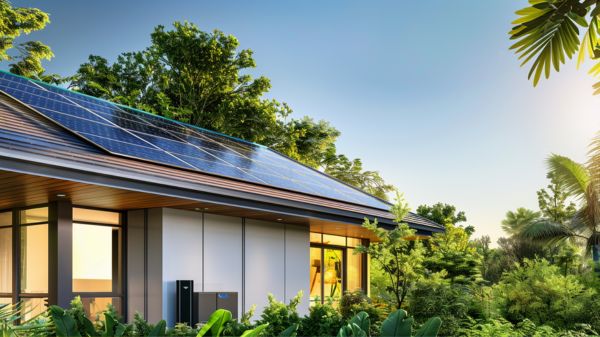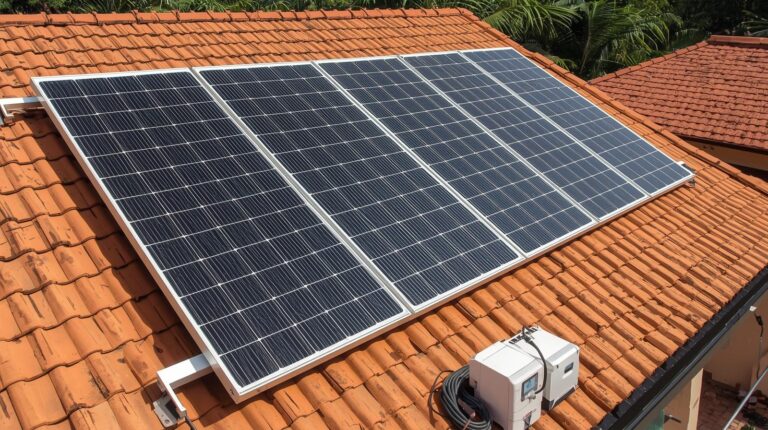In an era where sustainable energy solutions are becoming increasingly essential, choosing the right solar power kits for your home is paramount. This detailed guide highlights the top five complete solar power kits for homes available on the market, each tailored to meet diverse household energy requirements.
From the ECO WORTHY 200 Watt 12V Starter Kit to the robust 30KW Off Grid Home Solar Power System, these kits promise efficiency, reliability, and ease of installation. As we explore the intricacies of each option, you will discover the critical factors that make these kits stand out, ensuring an informed decision for your energy needs.
Exploring the Key Elements of A Solar Power Kit
An efficient solar power kit comprises three critical components: solar panels, solar inverters, and solar batteries.
Solar panels convert sunlight into electrical energy, while solar inverters transform this energy into a usable AC form for home appliances. Solar batteries provide storage solutions to guarantee a continuous power supply even during non-sunny periods, optimizing energy utilization and reliability.
1. Solar Panels
As the cornerstone of any complete solar power kit, solar panels convert sunlight into electricity through photovoltaic cells, greatly reducing reliance on traditional energy sources. The efficiency of these panels, often termed ‘panel efficiency,’ is crucial in determining the amount of sunlight converted into usable electricity. Modern advancements have led to significant improvements, with some panels achieving efficiency rates above 22%.
To maintain peak performance, proper cleaning methods are essential. Dust, debris, and bird droppings can diminish efficiency if not regularly addressed. Various cleaning solutions, including automated cleaning systems, can optimize these impacts.
Material options for solar panels vary, with monocrystalline and polycrystalline being the most prevalent. Monocrystalline panels, known for their high efficiency and sleek appearance, are often preferred for residential uses. Polycrystalline panels, while slightly less efficient, offer a cost-effective alternative.
Durability tests guarantee that solar panels withstand environmental stressors. These tests simulate extreme weather conditions, such as high winds, hail, and temperature fluctuations, to certify the panels’ longevity and reliability.
- Panel efficiency: Higher efficiency means more electricity from less space.
- Cleaning methods: Regular maintenance to sustain top performance.
- Material options: Monocrystalline vs. polycrystalline.
- Durability tests: Ensuring resilience against environmental stressors.
Considering these factors empowers homeowners to make informed decisions, optimizing their path towards energy independence.
2. Solar Inverters
Integral to the functionality of any solar power kit, solar inverters convert the direct current (DC) generated by solar panels into alternating current (AC), which is usable by home appliances and the electrical grid. The efficiency of a solar inverter, often exceeding 95%, is a pivotal metric that dictates how much of the harvested solar energy is effectively utilized.
Prominent inverter brands like SMA, SolarEdge, and Fronius are renowned for their high-efficiency ratings and robust inverter lifespan, often extending beyond 10 years with proper maintenance.
Inverter cooling mechanisms are critical to maintaining peak performance and prolonging the lifespan of the device. Advanced inverters incorporate passive cooling systems or active cooling fans to dissipate heat efficiently, thereby preventing thermal overload.
Inverter placement also plays a significant role in its overall efficiency and durability. Installing inverters in shaded, ventilated areas minimizes exposure to extreme temperatures and moisture, thereby enhancing their operational stability.
To maximize the benefits of your solar power kit, it is essential to select an inverter that not only matches your energy needs but also aligns with the latest technological advancements and industry standards. This strategic choice empowers homeowners to harness solar energy effectively, contributing to a sustainable and liberated energy future.
3. Solar Batteries
Critical to the reliability and autonomy of a solar power system, solar batteries store excess energy generated during peak sunlight hours for use during nighttime or cloudy conditions. These batteries ensure a continuous power supply, making your home energy-independent and resilient.
Understanding the key elements of solar batteries will aid in choosing the best storage solutions for your solar power kit. Battery capacity is paramount, determining the amount of energy stored and subsequently available for use. A higher capacity battery provides greater energy reserves, essential for ensuring prolonged power availability.
Charge cycles, indicative of a battery’s lifespan, measure how many times a battery can be charged and discharged before its capacity diminishes. More charge cycles equate to longer-lasting batteries.
Maintenance tips are vital for preserving battery health and efficiency. Regular inspections and proper handling can significantly extend battery life. Battery warranties offer additional security, covering potential defects and ensuring long-term reliability.
When evaluating solar batteries, consider these factors to maximize your system’s performance and longevity:
- Battery capacity: Determines stored energy amount.
- Charge cycles: Measures lifespan and efficiency.
- Maintenance tips: Ensures battery health and longevity.
- Battery warranties: Provides coverage for potential defects.
Understanding these elements helps in making informed decisions, empowering you towards energy liberation through solar power.
Exploring The Different Types Of Solar Power Kits
When considering solar power kits for residential use, it is essential to understand the distinctions among Off-Grid, Grid-Tied, Hybrid, and 3 Phase kits. Each type offers unique benefits and operational mechanisms, catering to different energy needs and infrastructure setups.
This section will provide a detailed analysis of these variations to guide informed decision-making for homeowners.
Off-Grid Solar Power Kits
Understanding the various types of off-grid solar power kits is essential for homeowners seeking energy independence and resilience against grid failures. This guide dives deep into the capabilities and applications of these systems, providing a data-driven perspective to empower your decision-making process.
Off-grid solar power kits offer unparalleled flexibility, allowing for seamless integration in diverse environments. Key features and advantages include:
- DIY installation: Many off-grid kits are designed for straightforward DIY installation, enabling homeowners to set up their systems without professional assistance, reducing costs, and promoting self-reliance.
- Portable options: Ideal for those who desire mobility, portable solar kits can be easily transported and set up in various locations, offering a versatile solution for camping, RVs, or temporary setups.
- Remote applications: These kits are particularly beneficial for remote applications, providing a reliable energy source for cabins, rural homes, or other locations far from the traditional power grid.
- Backup systems for emergency power: Off-grid systems can serve as robust backup systems, ensuring continuous power supply during emergencies or natural disasters when the grid is unavailable.
Grid-Tied Solar Power Kits Kits
While off-grid solar power kits provide autonomy and resilience, grid-tied solar power kits offer homeowners the advantage of integrating their solar energy system with the existing electrical grid, enhancing energy efficiency and potentially reducing electricity costs. These systems leverage utility integration to allow seamless energy flow between the solar array and the grid, enabling effective energy management.
One significant benefit of grid-tied systems is net metering, a billing mechanism that credits solar energy system owners for the electricity they add to the grid. When your solar panels produce excess energy, this surplus is fed back into the grid, and you earn energy credits. These credits can offset future electricity consumption, offering substantial savings on utility bills.
Moreover, grid-tied systems enhance grid reliability by contributing to the overall energy supply while maintaining stability. However, one limitation is their dependence on the grid for operation; during power outages, these systems typically shut down to prevent back-feeding, which could endanger utility workers.
Hybrid Kits
Hybrid solar power kits combine the benefits of both grid-tied and off-grid systems, offering homeowners a versatile solution for energy independence and reliability. These kits integrate solar panels, inverters, and battery storage to ensure continuous power supply, even during grid outages.
Designed for optimal energy management, hybrid systems support peak shaving by storing excess energy during off-peak hours and utilizing it during peak demand. This not only reduces electricity bills but also ensures a seamless transition between solar and grid power.
Hybrid benefits extend beyond just cost savings. The inclusion of battery storage ensures backup power during outages, enhancing the resilience of your home’s energy supply. Moreover, efficient load management allows for prioritizing critical appliances, further solidifying energy independence.
- Hybrid benefits: Merges grid-tied efficiency with off-grid autonomy.
- Backup power: Ensures uninterrupted power supply during grid failures.
- Load management: Customizes energy distribution to critical appliances.
- Peak shaving: Optimizes energy usage by storing and using power during peak periods.
3 Phase Kits
3 Phase kits represent another specialized category in the spectrum of solar power solutions, tailored to accommodate different stages of solar adoption and varying energy needs. These kits are meticulously designed to facilitate smooth progressions through various installation phases, guaranteeing that each stage of the solar implementation process is optimized for efficiency and effectiveness.
During the design phases, 3 phase kits can be customized to align with specific energy consumption patterns, architectural constraints, and long-term sustainability goals. This bespoke approach ensures that the system is scalable, allowing for future expansions during the system upgrade phases without significant overhauls or additional expenses.
In the installation phases, these kits come pre-configured with all necessary components, reducing installation time and complexity. This not only streamlines the initial setup but also minimizes labor costs and potential errors.
Furthermore, 3 phase kits simplify the maintenance phases by incorporating advanced monitoring systems and modular components. This makes routine checks and replacements more straightforward, thereby enhancing the system’s operational longevity and reliability.
Ultimately, 3 phase kits provide a robust framework for individuals seeking to liberate themselves from traditional energy dependencies, offering a structured yet flexible approach to achieving complete solar energy autonomy.
How Much Does A Solar Power Kit Cost?
The cost of a solar power kit for your home can vary greatly based on factors such as system size, quality of components, and installation requirements. When considering a solar power kit, it is important to explore budget considerations, financing options, and the overall cost breakdown.
Price trends in the solar industry have shown a steady decline in the cost of photovoltaic panels, making solar energy more accessible. However, understanding the return on investment is essential for making an informed decision.
Key elements influencing the cost include:
- System Size: Larger systems generally cost more but can offer higher energy savings over time.
- Component Quality: Premium components may have a higher upfront cost but offer better efficiency and durability.
- Installation Requirements: Complex installations can increase labor costs, impacting the overall budget.
- Incentives and Rebates: Government incentives can greatly reduce initial costs, enhancing the financial viability of the investment.
Key Factors for the Perfect Complete Solar Power Kits for Homes
When selecting the ideal complete solar power kit for your home, it is important to evaluate several key factors including:
- An accurate assessment of your energy needs
- The range of system size options
- Specific installation requirements
Additionally, understanding:
- The total cost
- Available incentives
- The warranty and support provided by the manufacturer
will guarantee a well-informed decision. By considering these critical elements, homeowners can optimize both the performance and financial benefits of their solar investment.
Energy Needs Assessment
Accurately evaluating your household’s energy consumption is essential for selecting an ideal complete solar power kit. Understanding your electrical demand involves a precise analysis of your power usage patterns and household requirements. This load estimation forms the foundation for determining the capacity and specifications of the solar power system you will need.
To effectively assess your energy needs, consider the following key factors:
- Historical Energy Consumption: Review past utility bills to determine your average monthly and annual energy usage. This provides a baseline for estimating your future electrical demand.
- Appliance Inventory: Create a detailed list of all electrical appliances and devices in your home, noting their power ratings and usage duration. This helps in identifying peak load times and critical energy needs.
- Lifestyle and Usage Patterns: Evaluate your daily and seasonal energy consumption behaviors. Consider variations in power usage due to changes in weather, occupancy, and specific lifestyle habits.
- Future Energy Requirements: Project any potential increases in energy consumption, such as the addition of new appliances, electric vehicles, or changes in household size. This forward-looking approach ensures your solar power system can accommodate future growth.
System Size Options
Determining the appropriate system size for your solar power kit involves analyzing multiple key factors such as energy consumption patterns, available roof space, and local solar irradiance levels. Accurate system sizing is vital to make sure your solar power kit meets your household’s power requirements efficiently.
Begin by scrutinizing your historical energy bills to understand your average monthly and annual energy consumption. This data forms the basis for your energy output and capacity calculation.
Next, assess your available roof space for panel installation. The physical dimensions and orientation of your roof impact the number of panels that can be installed and, consequently, the system’s overall capacity.
Local solar irradiance levels also play a pivotal role; regions with higher sunlight exposure will require fewer panels to generate the same energy output compared to less sunny areas.
Incorporating these factors into your system sizing process ensures that your selected solar power kit can meet your residential needs without oversizing or undersizing. This precision in capacity calculation maximizes efficiency and cost-effectiveness, empowering homeowners to achieve energy independence.
Installation Requirements
Choosing the right solar power kit necessitates a thorough understanding of installation requirements, which include structural integrity, electrical compatibility, and local permitting regulations. Ensuring that these elements are addressed not only guarantees a seamless installation but also maximizes the efficiency and longevity of your solar power system.
Key factors to take into account:
- Roof Assessments: Evaluate the condition and orientation of your roof to determine its suitability for solar panels. Structural requirements must be met to support the additional weight and potential wind loads.
- Electrical Inspections: Perform a detailed examination of your home’s electrical system to ensure compatibility with the new solar installation. This includes verifying that your current wiring, breaker panels, and inverters can handle the additional load.
- Permitting Process: Navigate the local permitting process, which often involves obtaining approval from municipal authorities and adhering to building codes. This step ensures legal compliance and safety standards are met.
- Utility Coordination: Coordinate with your local utility provider for grid connection and net metering arrangements. This step is essential for integrating your solar system with the public power grid and optimizing energy savings.
Cost and Incentives
Evaluating the cost and incentives linked to complete solar power kits for homes is essential for homeowners looking to make an informed investment in renewable energy solutions. The thorough understanding of available financial aids can alleviate this burden to a great extent. Government incentives play a pivotal role, offering federal tax credits that can reduce upfront costs by up to 26%. This credit is a substantial driver for potential adopters.
In addition to federal incentives, numerous states and municipalities offer rebate programs and financing options tailored to make solar power more accessible. These programs can cover a portion of the installation costs, further enhancing the financial feasibility of your solar investment.
Net metering is another critical factor. It allows homeowners to sell excess electricity generated by their solar panels back to the grid, thereby earning credits on their utility bills. This not only offsets energy costs but also accelerates the return on investment.
When evaluating solar power kits, it is imperative to take into account these financial mechanisms. A thorough understanding of government incentives, tax credits, rebate programs, and net metering can have a substantial impact on the overall cost-effectiveness of adopting solar energy, ultimately leading to long-term savings and energy independence.
Warranty and Support
Often underestimated, warranty and support are essential elements that have a substantial impact on the long-term reliability and performance of complete solar power kits for homes. Ensuring that your investment is safeguarded through an extended warranty and reliable customer support can make a significant difference in the efficacy and longevity of your solar power system.
Key considerations include:
- Warranty Terms: Investigate the duration and coverage scope of the warranty. A thorough warranty should cover both the panels and inverters, ideally for 25 years and 10 years, respectively.
- Extended Warranty Options: Some manufacturers offer extended warranty plans that provide additional years of coverage beyond the standard terms, which can be critical for long-term peace of mind.
- Customer Support and Technical Assistance: Evaluate the availability and quality of customer support. Prompt and knowledgeable technical assistance can resolve issues swiftly, minimizing downtime.
- Service Contracts: Explore service contracts that include regular maintenance and inspections. These contracts can ensure that your system operates at peak efficiency and can prevent costly repairs down the line.
Top 5 Amazon Complete Solar Power Kits for Homes
When evaluating the top 5 complete solar power kits available on Amazon, it is important to take into account the technical specifications and energy outputs of each system.
Highlighted options include:
- the ECO WORTHY 200 Watt 12V Starter Kit,
- the 30KW Off Grid Home Solar Power System, and
- the ExpertPower 20KWH 6480W 48V Kit.
Each of these kits offers distinct advantages in terms of power capacity, battery integration, and inverter efficiency, tailored to meet varying household energy needs.
1. ECO WORTHY 200 Watt 12V Complete Solar Panel Starter Kit
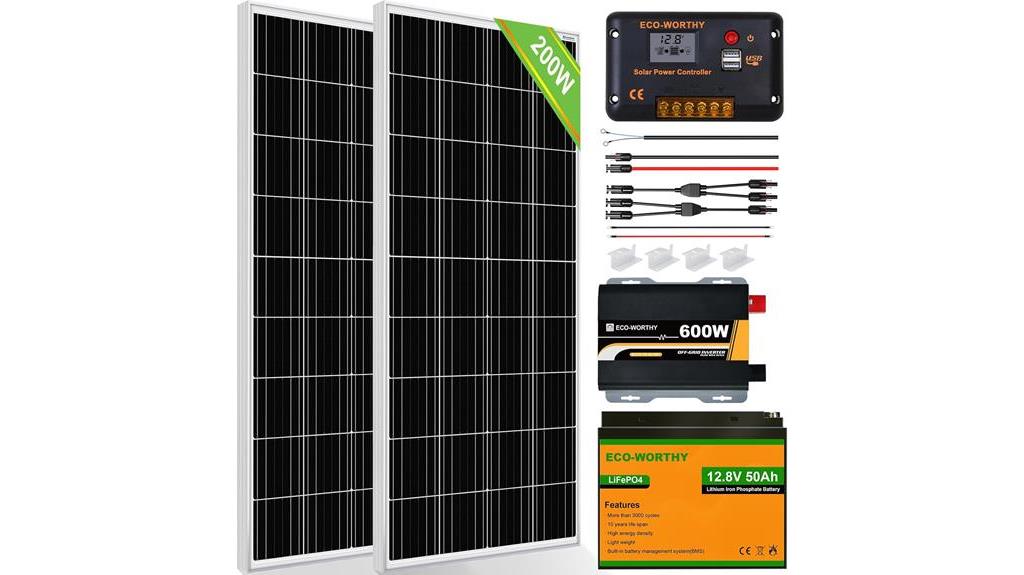
Designed for homeowners seeking a reliable and efficient entry point into solar energy, the ECO WORTHY 200 Watt 12V Complete Solar Panel Starter Kit offers a thorough solution that includes high-efficiency monocrystalline panels and essential installation hardware.
The kit features two 100W solar panels, each boasting a conversion efficiency of up to 21%. This efficiency is pivotal for maximizing energy capture, particularly in areas with variable sunlight. Additionally, the kit includes a 20A PWM charge controller, which efficiently manages the charging and discharging cycles, safeguarding battery longevity.
With pre-drilled holes for easy mounting and a set of Z-brackets, the installation process is streamlined. This kit serves as a robust foundation for those aiming to reduce dependency on conventional power sources and achieve energy independence.
2. 30KW Off Grid Solar System Complete Kit Home Solar Power System Complete kit
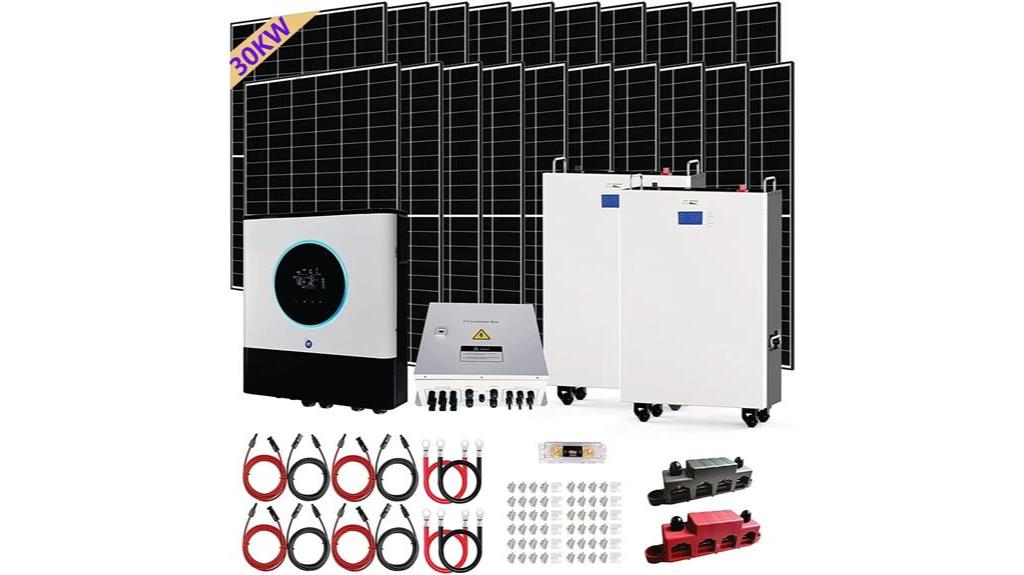
For homeowners seeking a reliable and efficient solution to power their residences independently, the KW Off Grid Solar System Complete Kit stands out as an excellent choice, combining advanced photovoltaic technology with user-friendly installation and maintenance features.
This robust system includes high-efficiency solar panels, a powerful inverter, and a durable battery bank, designed to maximize energy capture and storage. With a capacity ranging from 3KW to 10KW, it offers flexibility to meet varying household energy needs.
Industry data reveals that off-grid systems like this reduce dependence on traditional energy sources, providing significant cost savings over time. The kit’s modular design allows for easy scalability, enabling users to expand their system as their energy requirements grow, thus promoting a sustainable and autonomous lifestyle.
3. ECO WORTHY 4.8KWH Solar Power Complete Kit 1200W 24V with Lithium Battery and Inverter for Home
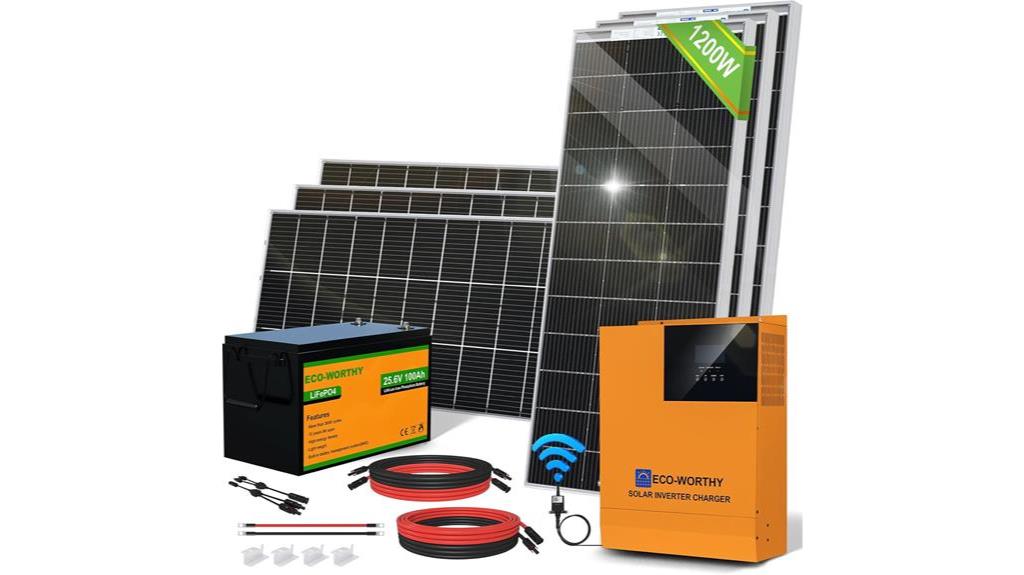
Suitable for homeowners seeking a reliable and high-capacity energy solution, the ECO WORTHY 4.8KWH Solar Power Complete Kit 1200W 24V features a robust lithium battery and an efficient inverter, ensuring consistent power supply and energy independence.
This all-inclusive kit includes high-efficiency monocrystalline panels, delivering a 1200W output capable of meeting various household energy demands. The integrated 4.8KWH lithium battery offers superior energy storage, with a longer lifecycle and faster charging times compared to traditional lead-acid batteries.
Coupled with a 24V inverter, this system efficiently converts solar energy into usable AC power, minimizing energy loss. Ideal for off-grid applications, this kit provides a sustainable pathway towards energy autonomy, empowering homeowners to reduce dependence on conventional power sources and embrace renewable energy.
4. ExpertPower 20KWH 6480W 48V Solar Power System Kit
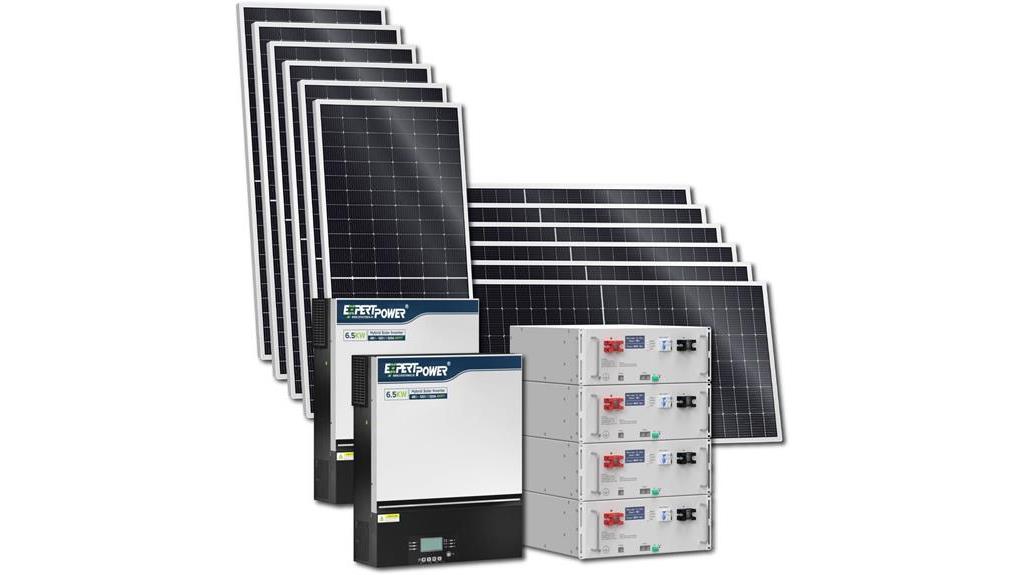
The ExpertPower 20KWH 6480W 48V Solar Power System Kit stands out as an excellent solution for homeowners seeking a robust and high-capacity solar energy system with reliable performance and efficiency.
This kit includes high-efficiency monocrystalline solar panels, which are known for their superior energy conversion rates, ensuring maximum power output. The integrated 48V inverter and lithium iron phosphate batteries provide enhanced energy storage and delivery, offering up to 20 kWh per day.
This capacity is ideal for powering larger homes or properties with higher energy demands. Additionally, the system’s modular design facilitates easy installation and scalability. Industry insights reveal that such high-capacity systems are pivotal in achieving energy independence and reducing reliance on traditional power grids, thereby fulfilling the desire for sustainable living.
5. ECO WORTHY 1.6KWH Complete Solar Panel Kit 400W 12V
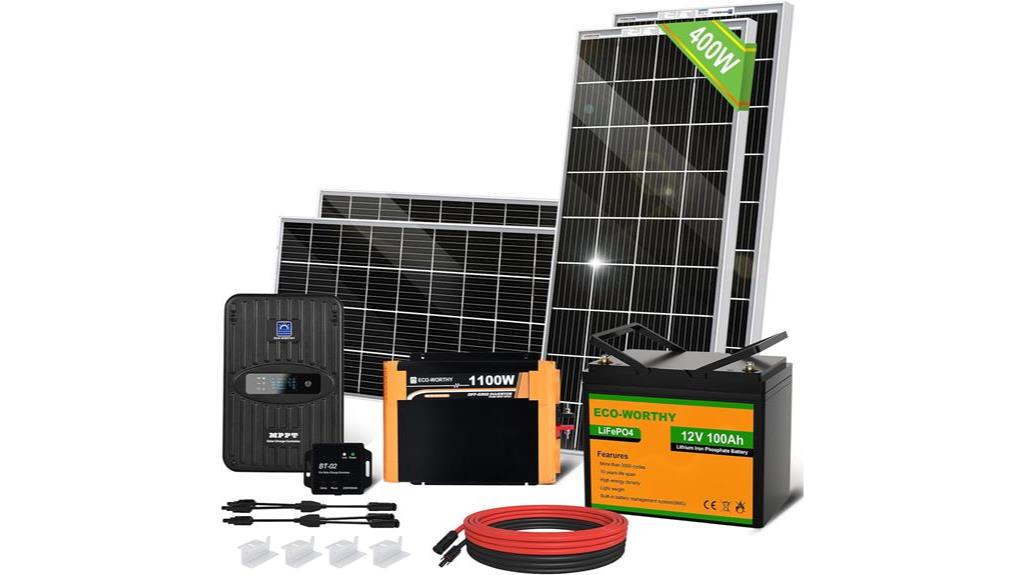
Ideal for homeowners seeking a reliable and efficient entry-level solution, the ECO WORTHY 1.6KWH Complete Solar Panel Kit 400W 12V offers a robust power output and easy installation. Engineered to deliver 1.6 kilowatt-hours of energy per day under ideal conditions, this kit combines four 100W monocrystalline panels known for high-efficiency rates.
The included 30A PWM charge controller guarantees precise regulation, enhancing battery longevity and system reliability. Additionally, the kit comprises a 1500W pure sine wave inverter, providing clean energy for sensitive electronics.
With its detailed instructions and pre-drilled holes, installation is streamlined, making it an excellent option for DIY enthusiasts. As a gateway to energy independence, the ECO WORTHY kit presents a cost-effective solution for reducing reliance on conventional power sources.
Key Factors for Successful Solar Power Kit Installation
Successful installation of a solar power kit hinges on several critical factors including the availability of the necessary installation tools, best roof mounting options, proper wiring and connections, and adherence to safety precautions.
A thorough understanding of these elements guarantees not only the efficiency but also the longevity and safety of your solar power system. Industry data shows that installations following these key factors experience a 15-20% improvement in performance metrics.
Necessary Installation Tools
Equipped with the right set of tools, the installation of a complete solar power kit becomes both efficient and effective, guaranteeing peak performance and longevity. The quality of tools directly influences the ease and safety of the installation process.
Reputable tool brands offer high-quality equipment that withstands rigorous use and enhances installation precision. Equally important is the proper use of safety gear to protect against potential hazards, such as electrical shocks and falls.
For a streamlined and successful installation, make sure you have a well-organized tool storage system. This minimizes downtime spent searching for tools and maximizes productivity. Installation manuals provided by solar kit manufacturers often detail the specific tools required, further simplifying the process.
Key tools and equipment to have on hand include:
- Cordless drill/driver: Essential for securing mounts and panels, a high-quality drill from trusted tool brands ensures reliability and longevity.
- Multimeter: A critical tool for verifying electrical connections and ensuring system performance, a reliable multimeter enhances installation accuracy.
- Torque wrench: Ensures that all bolts and screws are tightened to the manufacturer’s specifications, preventing future maintenance issues.
- Personal protective equipment (PPE): Includes gloves, safety glasses, and harnesses to safeguard against installation hazards.
Roof Mounting Options
Choosing the best roof mounting option is essential for ensuring both the structural integrity of your home and the efficiency of the solar power system. The ideal tilt angle for solar panels, generally between 15 to 40 degrees depending on your geographical location, maximizes energy absorption. As a result, adjustable mounting brackets are vital to fine-tune this angle throughout the year.
The roof material also plays a significant role in the mounting process. Asphalt shingles, metal roofs, and tile require different mounting techniques and hardware. Ensuring compatibility between mounting brackets and roof material mitigates potential damage and maintains structural integrity.
Weatherproof seals are indispensable in preventing leaks and ensuring the longevity of your installation. High-quality seals protect against water ingress, which is particularly important in regions prone to heavy rainfall or snowfall.
Weight distribution is another critical factor. Solar panels and their mounting systems can add significant load to your roof. Therefore, ensuring the weight is evenly distributed minimizes stress on structural components and prevents long-term damage.
Wiring and Connections
Ensuring proper wiring and connections is essential for the efficiency and safety of your solar power kit installation. Proper grounding, wire gauges, connection types, and other factors play pivotal roles in the overall performance of your system. Utilizing industry best practices guarantees not only peak energy output but also the longevity of your solar power kit.
Accurate selection and installation of wiring components require careful attention to detail and adherence to electrical standards. Here are some critical elements to take into account:
- Key Grounding: Ensuring all components are correctly grounded to prevent electrical faults and enhance the safety of the system.
- Wire Gauges: Choosing the correct wire gauge is essential to minimize resistance and energy loss, thereby improving efficiency.
- Connection Types: Using appropriate connectors and ensuring secure connections to avoid potential energy leakage and maintain consistent power flow.
- Junction Boxes and Conduit Placement: Strategically placing junction boxes and conduits protects wiring from environmental factors and simplifies maintenance.
Safety Precautions
Implementing rigorous safety precautions is an essential aspect of guaranteeing a successful and hazard-free solar power kit installation. Electrical hazards are the foremost concern, given the high voltage and current involved. It is crucial to use insulated tools and wear appropriate protective gear, such as rubber gloves and safety glasses, to mitigate the risk of electric shocks. Additionally, grounding all components correctly can prevent electrical faults.
Fire safety measures should not be overlooked. Ensure that your solar power kit is installed with proper ventilation to avoid overheating, and check that all electrical connections are secure and compliant with local codes. Installing smoke detectors near the system can provide an additional layer of protection.
Emergency procedures are paramount. Every household member should be aware of how to disconnect the solar system in case of an emergency. Mark the main switch clearly and provide a step-by-step guide on emergency shutdown procedures.
Childproofing measures are essential in homes with young children. Secure all exposed wires and components out of reach and consider installing lockable enclosures around critical system parts.
Related Post: DIY Solar Panel Installation Made Easy – From Start to Finish.
Tips for Optimal Efficiency and Savings
To guarantee your solar power kit delivers peak efficiency and savings, attention to ideal panel placement is crucial, as it directly impacts energy capture.
Additionally, implementing advanced battery storage strategies and enhancing inverter efficiency can greatly enhance system performance.
Regular maintenance and meticulous monitoring of system usage are essential practices that sustain long-term operational effectiveness and financial returns.
Optimal Panel Placement
Effective panel placement is essential for maximizing the efficiency of your solar power kit, as it directly impacts the amount of sunlight captured and converted into usable energy. The following key factors greatly influence ideal panel placement, ensuring your investment yields maximum returns.
- Sunlight Exposure: Prioritize areas on your property that receive the most consistent and direct sunlight throughout the day. It’s important to evaluate historical sunlight data to identify ideal exposure zones.
- Shading Analysis: Conduct a thorough shading analysis to detect and mitigate potential obstructions such as trees, buildings, or other structures that might cast shadows on the panels. Even partial shading can significantly reduce your system’s efficiency.
- Panel Orientation: Orient your panels to face true south in the Northern Hemisphere for maximum sunlight absorption. Fine-tuning the azimuth angle, based on your geographic location, can further enhance energy capture.
- Roof Angle: The inclination of your roof plays a crucial role in panel performance. Align the panels to match the roof angle or adjust them to the optimal tilt, typically between 30 to 45 degrees, to align with the sun’s trajectory.
Battery Storage Tips
Proper battery storage is vital for ensuring that your solar power kit operates at peak efficiency and provides maximum savings. To start, understanding battery capacity is essential. Choose a battery with sufficient capacity to store the energy you generate, accounting for daily consumption patterns and potential irregularities in sunlight.
Effective management of charging cycles is another critical element. Lithium-ion batteries, for instance, typically endure 500-1,000 charging cycles, while lead-acid variants may only sustain 300-700. Monitoring these cycles can prevent premature degradation, thereby extending battery lifespan.
Temperature management is a key factor in maintaining battery health. Batteries perform optimally within a specific temperature range, usually between 20°C to 25°C (68°F to 77°F). Extreme temperatures can reduce efficiency and longevity, so consider installing cooling systems or thermal insulation where needed.
Depth of discharge (DoD) also plays a significant role in battery performance. High DoD rates can strain your battery, reducing its lifespan. Aim for a balanced approach, utilizing 50-80% of the stored capacity to ensure longevity and consistent performance.
Inverter Efficiency Maximization
Maximizing advanced inverter technology is crucial for optimizing the efficiency and cost-effectiveness of your solar power kit. Properly managing key factors such as inverter placement, cooling strategies, load management, and inverter upgrades can lead to significant improvements in energy savings and system performance.
These optimizations guarantee that the energy harvested from your solar panels is utilized to its fullest potential.
Consider these strategies for maximizing inverter efficiency:
- Inverter placement: Position the inverter in a cool, shaded location to prevent overheating, which can degrade performance. Indoor installations often provide the most stable environment.
- Cooling strategies: Implement passive or active cooling methods to maintain ideal operating temperatures. This can include heat sinks, fans, or even liquid cooling systems for high-capacity inverters.
- Load management: Strategically distribute electrical loads to balance demand and prevent overloading the inverter. This not only prolongs the inverter’s lifespan but also enhances energy efficiency.
- Inverter upgrades: Regularly evaluate the performance of your current inverter and consider upgrading to newer models with higher efficiency ratings and advanced power conditioning capabilities.
Regular Maintenance Practices
Regular maintenance practices are pivotal for ensuring the longevity and efficiency of your solar power kit, complementing the gains made through inverter efficiency maximization. Establishing a consistent cleaning schedule is essential to prevent dirt and debris from obstructing sunlight, which can reduce energy output by up to 20%. Industry data suggests that bi-monthly cleaning is ideal for most environments.
In addition to cleaning, regular inspection routines should be implemented. These inspections should focus on identifying any physical damage to panels, loose wiring, or signs of corrosion. System diagnostics should be performed quarterly to ascertain the electrical health of the entire setup, ensuring that all components are functioning within their specified parameters.
Hardware checks are equally critical. These should include examining the mounting structures for stability and the integrity of the inverter and battery storage systems.
Employing preventative measures, such as using weather-resistant materials and surge protectors, can mitigate potential damage from environmental factors and electrical surges.
Monitoring System Usage
Effective monitoring of system usage is critical for optimizing the performance and maximizing the savings of your solar power kit. Leveraging advanced system monitoring tools enables homeowners to achieve significant efficiency gains and cost reductions. By integrating real-time analytics, you can gain immediate insights into how your solar panels are performing, allowing for prompt adjustments and maintenance.
Key aspects of effective system monitoring include:
- Real-time analytics: Provides instantaneous data on energy production and consumption, allowing you to swiftly identify and address inefficiencies.
- Usage trends: Track historical data to understand patterns in energy usage, helping you make informed decisions about energy conservation and consumption habits.
- Consumption forecasting: Utilize predictive models to estimate future energy needs based on past usage, seasonal variations, and other relevant factors, ensuring peak system performance.
- Data tracking: Continuously monitor key performance metrics to maintain a thorough understanding of your system’s health and efficiency.
Optimizing Performance: Key Practices for Routine Maintenance
To guarantee maximum efficiency and longevity, maintaining your home solar power kit requires a systematic approach to routine inspections and cleaning.
Cleaning panels is essential; dirt and debris can greatly reduce the system’s energy capture. According to industry data, even a thin layer of dust can diminish solar panel efficiency by up to 20%. Use deionized water and soft brushes to avoid scratching the panel surface.
Inspecting wiring should be conducted quarterly to identify any wear or potential hazards. Faulty or damaged wiring can lead to energy loss and even safety risks. Employ a multimeter to make sure all connections are secure and functioning optimally.
Checking inverters is another important step. Inverters convert the direct current (DC) produced by your panels into usable alternating current (AC). Regularly review the inverter’s performance metrics to detect any anomalies.
Monitoring batteries, especially for off-grid systems, helps in maintaining charge efficiency and lifespan. Utilize battery management systems (BMS) to keep track of charging cycles and temperatures.
Updating software is often overlooked but critical. Firmware updates can enhance system performance and security. Consult the manufacturer’s guidelines for the latest updates to make sure your system operates with cutting-edge efficiency.
Conclusion
Selecting the perfect complete solar power kits for homes involves careful consideration of power capacity, efficiency, and installation ease. The ECO WORTHY 200 Watt 12V Starter Kit, the 30KW Off Grid Home Solar Power System, and the ExpertPower 20KWH 6480W 48V Kit exemplify top choices.
Evaluating cost, key installation factors, and maintenance practices further ensures peak performance and energy savings. Thorough understanding and strategic application can greatly enhance residential solar power utilization.

